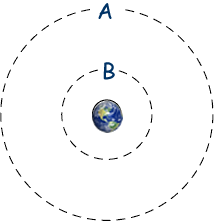Gravitational Fields Questions
Q2.
(a)
(i) State the relationship between the gravitational potential energy, Ep, and the gravitational potential, V, for a body of mass m placed in a gravitational field.
(1 mark)
(ii) What is the effect, if any, on the values of Ep and V if the mass m is doubled?
(2 marks)
(b)

The diagram above shows two of the orbits, A and B, that could be occupied by a satellite in circular orbit around the Earth, E.
The gravitational potential due to the Earth of each of these orbits is:
| orbit A |
– 12.0 MJ kg–1 |
| orbit B |
– 36.0 MJ kg–1 |
(i) Calculate the radius, from the centre of the Earth, of orbit A.
(2 marks)
(ii) Show that the radius of orbit B is approximately 1.1 × 104 km.
(1 mark)
(iii) Calculate the centripetal acceleration of a satellite in orbit B.
(2 marks)
(iv) Show that the gravitational potential energy of a 330 kg satellite decreases by about 8 GJ when it moves from orbit A to orbit B.
(1 mark)
(c) Explain why it is not possible to use the equation  Ep = mg
Ep = mg h when determining the change in the gravitational potential energy of a satellite as it moves between these orbits.
h when determining the change in the gravitational potential energy of a satellite as it moves between these orbits.
(1 mark)
(10 marks Total)



